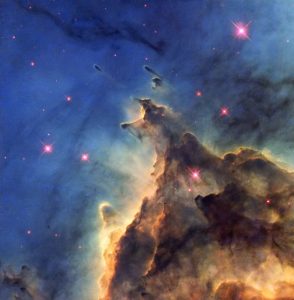Giovani stelle in lotta per la sopravvivenza

Il telescopio Hubble ha ripreso un vivaio stellare chiamato Nebulosa Testa di Scimmia (Monkey Head Nebula, NGC 2174), in cui le stelle sono soggette a una frenetica lotta per la sopravvivenza.
La questione è che la formazione stellare è un processo molto inefficiente; la maggior parte degli ingredienti per creare le stelle vanno sprecati quando la nube di gas e polveri si disperde gradualmente. In NGC 2174, la velocità con cui la nebulosa va disperdendosi è ulteriormente accelerata dalla presenza di giovani stelle calde che soffiano venti ad alta velocità in grado di spazzare via il gas verso l’esterno.
Queste stelle infuocate bombardano il gas circostante con intense radiazioni, rendendolo brillante, e creando la splendida scena ripresa in questa immagine. La nebulosa è per lo più composta da idrogeno, ionizzato dalla radiazione ultravioletta emessa dalle calde stelle: si tratta infatti di una regione HII. Questa immagine mostra solo una parte della nebulosa, in le nubi oscure di polvere si stagliano in modo misterioso e affascinante sul gas incandescente.
NGC 2174 si trova a circa 6400 anni luce di distanza nella costellazione di Orione. L’oggetto fu scoperto nel 1877 dall’astronomo francese Jean Marie Edouard Stephan, presso l’Observatoire de Marseille.
[ Barbara Bubbi ]
https://www.spacetelescope.org/images/potw1106a/
Credit: ESA/Hubble & NASA
Lascia un commento